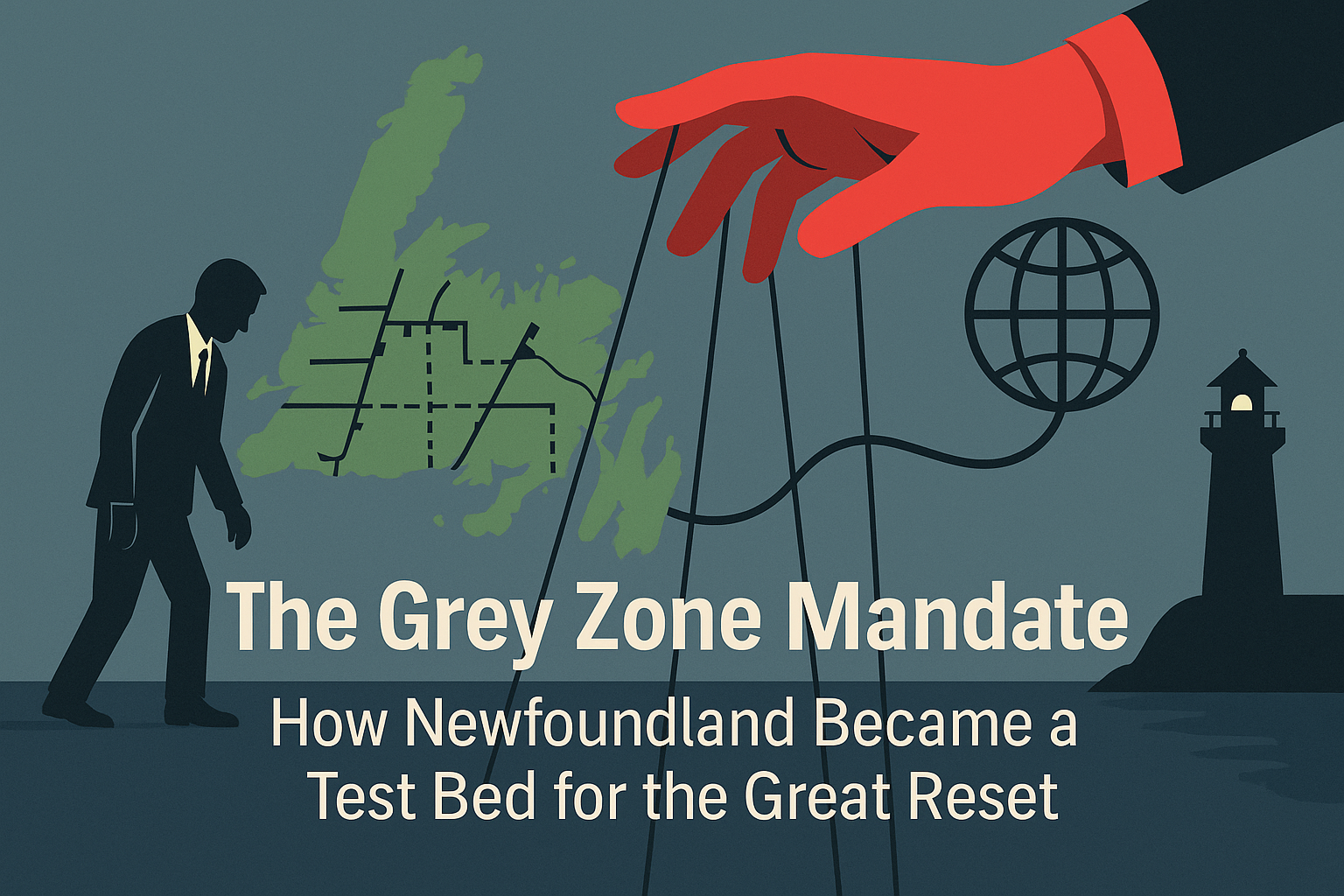The Grey Zone Begins: When Government Without Governance Creates a Power Vacuum
Newfoundland is governed — but not in the way most people imagine.
There are rules, regulations, and officials, yes. But beneath the surface lies a profound absence of strategic direction. What exists instead is a “grey zone” of soft authority, where government functions more like a channel for external mandates than a driver of independent vision.
This isn't accidental. It’s a pattern.
Scholars like Van Assche describe this as the “local paradox”: “A place might be fully embedded in networks of governance and still not be governed well... Structures become decoupled from the people they are supposed to serve.”⁴
In Newfoundland, this paradox isn’t theoretical. It is the operating system.¹
Governance Without Teeth: The Perfect Laboratory for Global Plans
Why Newfoundland?
Because it’s structurally ideal for experimentation:
- Small population, large landmass – Big returns on low-risk pilots
- Fiscal dependency – Receptive to outside capital and guidance
- Dispersed councils with minimal authority – No strong local checks on top-down policy
- Economic precarity – A population primed to accept “green jobs” and “reset solutions”
These vulnerabilities didn’t just emerge — they were cultivated by decades of reactive governance and project-based development. They’ve created what Van Assche calls a “thinness of strategic agency at the local level.”⁴
Into that void step NGOs, consultants, and multinational consortia.
This “governance vacuum” creates space for foreign investment, UN-aligned programs, and ESG-financed transformations — all under the guise of economic revitalization.²
The province becomes a stage, where public services are quietly privatized, renewable energy projects are greenlit without scrutiny, and rural areas are reclassified for conservation or industry with minimal consultation.³
The Agenda 2030 Overlay: From Local Consultation to Global Coordination
The buzzwords arrive first:
Sustainability. Inclusion. Innovation. Net-zero.
But behind the language is a binding framework — Agenda 2030, enforced via agreements like the Paris Accord and financial levers like GFANZ, the Glasgow Financial Alliance for Net Zero. These levers give unelected financial actors real power to shape domestic policy in places desperate for capital.⁵
In Newfoundland, this appears as:
- Wind and hydrogen megaprojects that export energy but bypass local needs
- Soft consultation initiatives like the ABCD Project that manage perception, not policy⁶
- Conservation land grabs linked to the 30×30 target — reframed as environmental “protection” but mapped without consent⁷
- Digital transformation pilots tied to federal grants and international partnerships
These aren’t just policy shifts. They are structural alignments with a new global governance model — one where technocratic oversight and ESG compliance take precedence over local democracy.
In this system, elected councils become implementation arms, not decision-makers.
The Grey Zone Expands: Consent Without Clarity
The genius of the grey zone is its ambiguity.
Projects move forward without ever crossing formal lines of illegality. Consultations occur, but decisions are pre-baked. Councils approve, but funding terms are set far above them. Locals are included in the optics, but excluded from the outcome.
This is not colonialism in the old sense. It’s green colonialism, cloaked in phrases like “sustainable development” and “climate justice.”⁷
The reset logic is clear:
- Land must be reclassified for conservation, carbon crediting, or industrial transition
- Energy must be exported, not owned
- Consent must be simulated, not secured
And Newfoundland, with its layered dependence, bureaucratic fatigue, and fading media scrutiny, becomes an ideal proving ground.
It’s no coincidence that Ali Chaisson — a longtime energy strategist whose career spans fracking, exploration lobbying, and multinational brokerage — now works with firms like XMi Systems and LEXA Intelligence, offering data-driven consulting while maintaining long-standing ties to energy and public-sector networks. His corporate history links Newfoundland’s political class with French capital, particularly through ventures tied to SCDM, the Bettencourt family's holding company.⁸
Likewise, Tony Cornect — once a provincial cabinet minister — has stepped back from public life into the safety of French-backed regional organizations. These institutions act as both cultural shields and soft implementation vehicles for broader economic transitions.
The Local Trap: Why Resistance Keeps Getting Recycled
Ironically, even local pushback often reinforces the system.
Activists are baited into focusing on the symptoms (wind turbines, local mayors) rather than the systemic scaffolding underneath. Protest becomes performance, and oppositional groups are fractured or co-opted.
Meanwhile:
- Public consultations are facilitated by federal agencies or paid intermediaries
- Chief Mi’sel Joe lends legitimacy to World Energy GH₂ — a megaproject deeply tied to European capital and carbon trading — while deeper questions of Indigenous sovereignty are papered over⁷
- Energy boards rebrand from petroleum to “offshore energy,” maintaining the same power structures under new climate labels
The pattern is always the same: every entry point leads back to the grey zone
The Mandate Behind the Mandates
Newfoundland’s fate in the Great Reset isn’t just about policy.
It’s about narrative control, governance decay, and the quiet absorption of local identity into a global compliance structure.
This is the Grey Zone Mandate:
To appear locally anchored, while being globally aligned
To promise empowerment, while delivering enclosure
To simulate consent, while bypassing sovereignty
As anthropologist James Ferguson warned, development narratives can depoliticize real power structures by masking global influence as “technical problem solving.”⁹
And unless that pattern is broken — not just protested, but named — Newfoundland will remain a test case for a future it did not choose.
Crosslinked Articles
When the Bank Calls the Shots³
References
[1] https://baymansparadox.com/explore/governance/post.php?id=132
[2] https://baymansparadox.com/explore/governance/post.php?id=151
[3] https://baymansparadox.com/explore/local-paradox/post.php?id=144
[4] Van Assche, K., Gruezmacher, M., & Ghorbani, M. (2022). The local paradox in grand policy schemes: Lessons from Newfoundland and Labrador. Scandinavian Journal of Public Administration, 26(2), 3–26. (Local Download)
[5] Aklin, M., & Mildenberger, M. (2020). Prisoners of the Wrong Dilemma: Why Distributive Conflict, Not Collective Action, Characterizes the Politics of Climate Change. Global Environmental Politics, 20(4), 4–27. https://papers.ssrn.com/sol3/papers.cfm?abstract_id=3281045
[6] https://baymansparadox.com/explore/local-paradox/post.php?id=127
[7] https://baymansparadox.com/explore/governance/post.php?id=149
[8] https://baymansparadox.com/explore/governance/post.php?id=152
[9] Ferguson, J. (1994). The Anti-Politics Machine: “Development,” Depoliticization, and Bureaucratic Power in Lesotho. University of Minnesota Press. https://www.upress.umn.edu/book-division/books/the-anti-politics-machine

